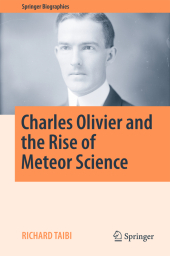 Neuerscheinungen 2017Stand: 2020-02-01 |
Schnellsuche
ISBN/Stichwort/Autor
|
Herderstraße 10
10625 Berlin
Tel.: 030 315 714 16
Fax 030 315 714 14
info@buchspektrum.de |

Richard Taibi
Charles Olivier and the Rise of Meteor Science
1st ed. 2017. 2017. xxxii, 497 S. 28 SW-Abb., 1 Farbabb. 235 mm
Verlag/Jahr: SPRINGER, BERLIN; SPRINGER INTERNATIONAL PUBLISHING 2017
ISBN: 3-319-44517-0 (3319445170)
Neue ISBN: 978-3-319-44517-5 (9783319445175)
Preis und Lieferzeit: Bitte klicken
This fascinating portrait of an amateur astronomy movement tells the story of how Charles Olivier recruited a hard-working cadre of citizen scientists to rehabilitate the study of meteors. By 1936, Olivier and members of his American Meteor Society had succeeded in disproving an erroneous idea about meteor showers. Using careful observations, they restored the publicīs trust in predictions about periodic showers and renewed respect for meteor astronomy among professional astronomers in the United States. Charles Olivier and his society of observers who were passionate about watching for meteors in the night sky left a major impact on the field.
In addition to describing Olivierīs career and describing his struggles with competitive colleagues in a hostile scientific climate, the author provides biographies of some of the scores of women and men of all ages who aided Olivier in making shower observations, from the Leonids and Perseids and others. Half of these amateur volunteers were from 13 to 25 years of age. Their work allowed Olivier and the AMS to contradict the fallacious belief in stationary and long-enduring meteor showers, bringing the theory of their origin into alignment with celestial mechanics. Thanks to Olivier and his collaborators, the study of meteors took a great leap forward in the twentieth century to earn a place as a worthy topic of study among professional astronomers.
Chapter 1:Fortunes of War and Peace.- Chapter 2: Virginiaīs Astronomer.- Chapter 3: Young Charles.- Chapter 4: The1800 Leonids.- Chapter 5: Portrait of the Young Man as an Astronomer.- Chapter 6: Sojourn at Lick Observatory.- Chapter 7: Doctor of Philosophy.- Chapter 8: Starting Out.- Chapter 9: Friends at McCormick Observaotry.- Chapter 10: Society for Practical Astronomy.- Chapter 11: American Astronomical Society.- Chapter 12: American Association of Variable Star Observers.-Chapter 13: The Weather Bureau.- Chapter 14: Hydrographic Office of the US Navy.- Chapter 15: New Members Join the American Meteor Society, 1915 to 1918.- Chapter 16: Membership Roster 1915-1918.-Chapter 17: Outcomes of Olivierīs Membership Efforts, 1911 to 1918.- Chapter 18: Trans-Atlantic Controversy.- Chapter 19: W. F. Denning, A. S. Herschel, and Stationary Radiants.- Chapter 20: The First Assignment: Discredit Stationary Radiants.- Chapter 21: Top Achievers 1914-1925.- Chapter 22: Challenges for Olivier and the American Meteor Society.- Chapter 23: The Rise of Astrophysics.- Chapter 24: Membership roster 1919-1929.- Chapter 25: Advances Made by the American Meteor Society 1919-1929.- Chapter 26: The Best of Times During the Worst of Times.- Chapter 27: The Man at Mid-Life.- Chapter 28: The Astronomer at Mid-Life.- Chapter 29: Organizing Observatory Staff for the Leonids.- Chapter 29: Organizing Observatory stff for the Leonids.- Chapter 30: Membership Roster 1930-1936.- Chapter 31: How the Meteor Quest Was Won.- Chapter 32: What the AMS Accomplished.- Chapter 33: Citizen Scientists Caught Meteor Fever.- Chapter 34: Contemporary Meteor Organizations in the United States.- Chapter 35: Outside the USA: A Survey of Meteor Astronomers and Organizations.- Chapter 36: Summing Up: Olivier at Mid-Life.- Chapter 37: Who Were These Men and Women? Appendices.- Index
"C.P. Olivier is a famous name in the annals of meteor astronomy, and it is a pleasure to learn more about him ... . Each chapter is complete with extensive footnotes (some of which even extend for more than half a page), and at the end a list of references. So we have much to thank Richard Taibi for in producing this timely book, which belongs on the bookshelves of all avid visual meteor observers with an interest in history." (Wayne Orchiston, Journal of Astronomical History and Heritage, December, 2017)
"This concisely written book provides wonderful discussions on the discovery, verification, and disputes surrounding all twenty-six tranuranic elements. ... From Transuranic to Superheavy Elements is geared to historians of science, chemists, and physicists, rather than a general audience." (Howard G. Barth, Isis, Vol. 110 (1), March, 2019)


